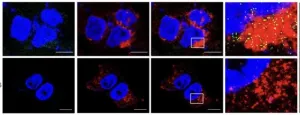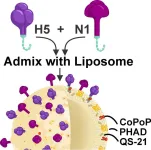(Press-News.org) Based on data from over 1000 regional studies combined with machine learning, researchers estimate that as many as 1.4 billion people live in areas with soil dangerously polluted by heavy metals like arsenic, cadmium, cobalt, chromium, copper, nickel, and lead. The study reveals a global risk, but also a previously unrecognized high-risk, metal-enriched zone in low-latitude Eurasia, in particular. The growth in demand for critical metals means toxic heavy metal pollution in soils is only likely to worsen. “We hope that the global soil pollution data presented in this report will serve as a scientific alert for policymakers and farmers to take immediate and necessary measures to better protect the world’s precious soil resources,” say the authors. Toxic heavy metal pollution in soil, originating from both natural sources and human activities, poses significant risks to ecosystems and human health. Once introduced into soils, such metals can persist over decades. These pollutants reduce crop yields, affect biodiversity, and jeopardize water quality as well as food safety through bioaccumulation in farm animals. However, while previous studies have shown that toxic metal pollution is ubiquitous in soils, its worldwide distribution remains poorly understood. To address this knowledge gap, Deyi Hou compiled data from 1,493 regional studies encompassing 796,084 soil samples to assess the global distribution of toxic metals in agricultural soils and to identify where concentrations exceed safety thresholds. Using machine learning and modeling approaches, Hou et al. estimate that 14–17% of cropland globally – roughly 242 million hectares – is contaminated by at least one toxic metal, with cadmium being the most widespread, especially in South and East Asia, parts of the Middle East, and Africa. Nickel, chromium, arsenic, and cobalt also exceeded thresholds in various regions, largely due to a mix of natural geological sources and human activities such as mining and industrialization. Moreover, findings revealed a transcontinental “metal-enriched corridor” stretching across low-latitude Eurasia, which likely reflects the cumulative effects of ancient mining, weathering of metal-rich bedrock, and limited leaching over time. By superimposing these data with global population distribution, Hou et al. estimate that 0.9 to 1.4 billion people live in high-risk areas.
END
Up to 17% of global cropland contaminated by toxic heavy metal pollution, study estimates
Summary author: Walter Beckwith
2025-04-17
ELSE PRESS RELEASES FROM THIS DATE:
Curiosity rover finds large carbon deposits on Mars
2025-04-17
Research from NASA’s Curiosity rover has found evidence of a carbon cycle on ancient Mars, bringing scientists closer to an answer on whether the Red Planet was ever capable of supporting life.
Lead author Dr. Ben Tutolo, PhD, an associate professor with the Department of Earth, Energy and Environment in the Faculty of Science at the University of Calgary, is a participating scientist on the NASA Mars Science Laboratory Curiosity Rover team.
The team is working to understand climate transitions and habitability on ancient Mars as Curiosity explores Gale Crater.
The paper, published this week in the journal Science, reveals that ...
CHOP, Penn Medicine researchers use deep learning algorithm to pinpoint potential disease-causing variants in non-coding regions of the human genome
2025-04-17
Philadelphia, April 17, 2025 – Researchers from Children’s Hospital of Philadelphia (CHOP) and the Perelman School of Medicine at the University of Pennsylvania (Penn Medicine) have successfully employed an algorithm to identify potential mutations which increase disease risk in the noncoding regions our DNA, which make up the vast majority of the human genome. The findings could serve as the basis for detecting disease-associated variants in a range of common diseases. The findings were published online today by the American Journal of Human Genetics.
While certain sections ...
Prevalence of obesity with and without confirmation of excess adiposity among US adults
2025-04-17
About The Study: Among U.S. adults ages 20 to 59, the prevalence of obesity by body mass index (BMI) only was nearly identical with the obesity prevalence after confirmation of excess adiposity. Approximately 98% of individuals identified as having obesity based on BMI had excess adiposity.
Corresponding Author: To contact the corresponding author, Michael Fang, PhD, MHS, email mfang9@jh.edu.
To access the embargoed study: Visit our For The Media website at this link https://media.jamanetwork.com/
(doi:10.1001/jama.2025.2704)
Editor’s Note: Please ...
Population attributable fraction of incident dementia associated with hearing loss
2025-04-17
About The Study: The results of this cohort study suggest that treating hearing loss might delay dementia for a large number of older adults. Public health interventions targeting clinically significant audiometric hearing loss might have broad benefits for dementia prevention. Future research quantifying population attributable fractions should carefully consider which measures are used to define hearing loss, as self-reporting may underestimate hearing-associated dementia risk.
Corresponding Author: To contact the corresponding ...
New study reveals how cleft lip and cleft palate can arise
2025-04-17
CAMBRIDGE, MA -- Cleft lip and cleft palate are among the most common birth defects, occurring in about one in 1,050 births in the United States. These defects, which appear when the tissues that form the lip or the roof of the mouth do not join completely, are believed to be caused by a mix of genetic and environmental factors.
In a new study, MIT biologists have discovered how a genetic variant often found in people with these facial malformations leads to the development of cleft lip and cleft palate.
Their findings suggest that the variant diminishes cells’ supply of transfer RNA, a molecule ...
Scientists hack cell entry to supercharge cancer drugs
2025-04-17
A new discovery could pave the way for more effective cancer treatment by helping certain drugs work better inside the body.
Scientists at Duke University School of Medicine, University of Texas Health Science Center at San Antonio, and University of Arkansas have found a way to improve the uptake of a promising class of cancer-fighting drugs called PROTACs, which have struggled to enter cells due to their large size.
The new method works by taking advantage of a protein called CD36 that helps pull substances into cells. By designing drugs to use this CD36 pathway, researchers delivered 7.7 to 22.3 times more of the drug inside cancer cells, making ...
Study: Experimental bird flu vaccine excels in animal models
2025-04-17
BUFFALO, N.Y. — A vaccine under development at the University at Buffalo has demonstrated complete protection in mice against a deadly variant of the virus that causes bird flu.
The work, detailed in a study published today (April 17) in the journal Cell Biomaterials, focuses on the H5N1 variant known as 2.3.4.4b, which has caused widespread outbreaks in wild birds and poultry, in addition to infecting dairy cattle, domesticated cats, sea lions and other mammals.
In the study, scientists describe a process they’ve developed for creating doses with precise ...
Real-world study finds hydroxyurea effective long-term in children living with sickle cell disease
2025-04-17
(WASHINGTON, April 17, 2024) — Hydroxyurea remains effective long-term in reducing emergency department visits and hospital days for children living with sickle cell disease (SCD), according to new research published in Blood Advances.
“This is one of the first large, real-world, long-term studies to assess the efficacy of hydroxyurea outside of a controlled setting,” said study author Paul George, MD, a pediatric hematology/oncology fellow and PhD candidate at Emory University School of Medicine and Aflac Cancer and Blood Disorders Center at Children’s ...
FAU designated a National Center of Academic Excellence in Cyber Research
2025-04-17
Florida Atlantic University has been recognized as a National Center of Academic Excellence in Cyber Research (CAE-R) by the National Security Agency (NSA) and its partners in the National Centers of Academic Excellence in Cybersecurity (NCAE-C). This prestigious designation, awarded through the academic year 2030, affirms the university’s leadership and innovation in the field of cybersecurity research at the doctoral level.
This recognition places FAU among an elite group of institutions nationwide that have demonstrated a sustained commitment to cutting-edge research in cyber defense and security. The CAE-R designation is awarded to universities whose programs meet rigorous ...
European potato genome decoded: Small gene pool with large differences
2025-04-17
A research team has decoded the genome of historic potato cultivars and used this resource to develop an efficient method for analysis of hundreds of additional potato genomes.
Potatoes are a staple food for over 1.3 billion people. But despite their importance for global food security, breeding successes have been modest. Some of the most popular potato cultivars were bred many decades ago. The reason for this limited success is the complex genome of the potato: there are four copies of the genome in each cell instead of just two. ...
LAST 30 PRESS RELEASES:
New study overturns long-held model of how plants coordinate immune responses.
New AI model predicts disease risk while you sleep
Scientists discover molecular ‘reshuffle’ and crack an 80-year-old conundrum
How stressors during pregnancy impact the developing fetal brain
Electrons lag behind the nucleus
From fungi to brain cells: one scientist's winding path reveals how epigenomics shapes neural destiny
Schizophrenia and osteoporosis share 195 genetic loci, highlighting unexpected biological bridges between brain and bone
Schizophrenia-linked genetic variant renders key brain receptor completely unresponsive to both natural and therapeutic compounds
Innovative review reveals overlooked complexity in cellular energy sensor's dual roles in Alzheimer's disease
Autism research reframed: Why heterogeneity is the data, not the noise
Brazil's genetic treasure trove: supercentenarians reveal secrets of extreme human longevity
The (metabolic) cost of life
CFRI special issue call for papers: New Frontiers in Sustainable Finance
HKU Engineering scholar demonstrates the smallest all-printed infrared photodetectors to date
Precision empowerment for brain "eavesdropping": CAS team develops triple-electrode integrated functional electrode for simultaneous monitoring of neural signals and chemical transmitters during sleep
Single-capillary endothelial dysfunction resolved by optoacoustic mesoscopy
HKU three research projects named among ‘Top 10 Innovation & Technology News in Hong Kong 2025’ showcasing excellence in research and technology transfer
NLRSeek: A reannotation-based pipeline for mining missing NLR genes in sequenced genomes
A strand and whole genome duplication–aware collinear gene identification tool
Light storage in light cages: A revolutionary approach to on-chip quantum memories
Point spread function decoupling in computational fluorescence microscopy
BacPhase: Long-insert paired-end sequencing for bin marker construction and genome phasing
GmWOX1 regulates the mediolateral polarity of compound leaves in soybean
ChargeFabrica: An open-source simulation tool that aims to accelerate search for high performance perovskite solar cells
High levels of ADAR overexpression induce abundant and stochastic off-target RNA editing in rice protoplasts
On-demand upgraded recycling of polyethylene and construction of sustainable multifunctional materials based on the "LEGO" strategy
New "Stomata in-sight" system allows scientists to watch plants breathe in real-time
Anorexia nervosa may result in long-term skeletal muscle impairment
Narrative-based performance reviews deemed fairest by employees
New insights reveal how advanced oxidation can tackle emerging water pollutants
[Press-News.org] Up to 17% of global cropland contaminated by toxic heavy metal pollution, study estimatesSummary author: Walter Beckwith


